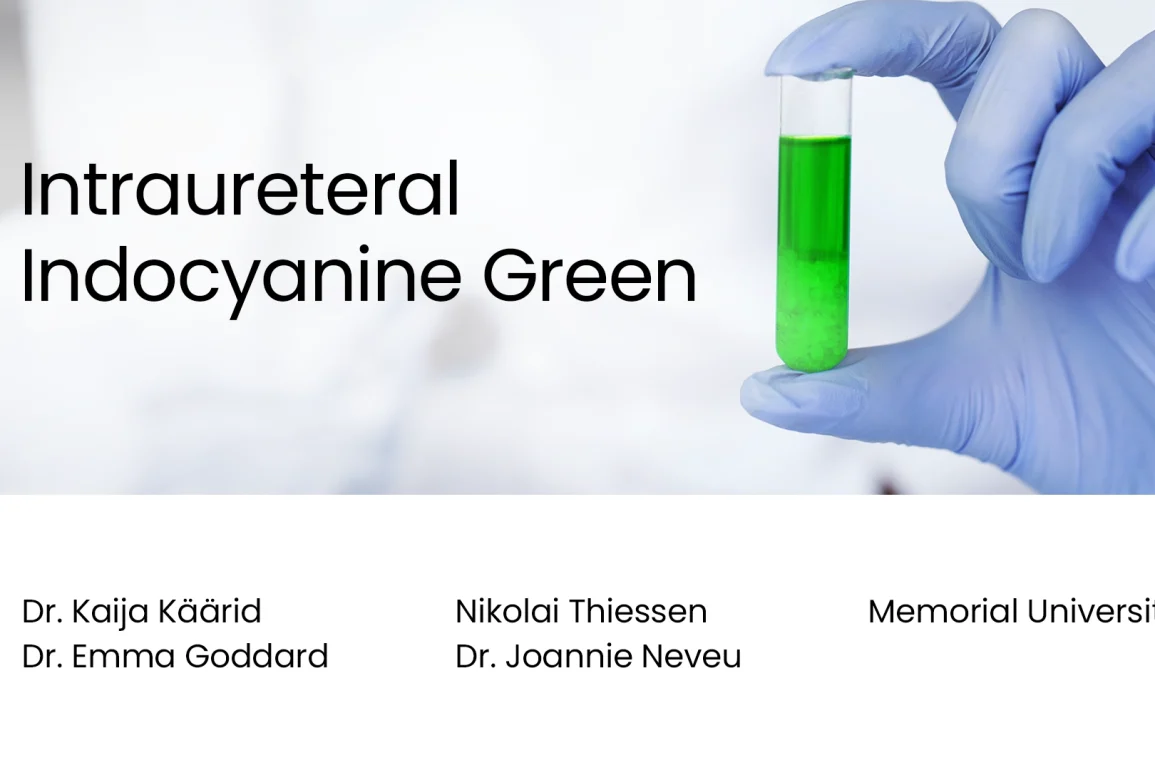Table of Contents
- Procedure Summary
- Authors
- Youtube Video
- What is Intraureteral Indocyanine Green?
- What are the Risks of Intraureteral Indocyanine Green?
- Video Transcript
Video Description
Use of intraureteral indocyanine green dye to enhance real-time visualization and localization of the ureters during complex laparoscopic pelvic surgery.
Presented By
Affiliations
Memorial University
Watch on YouTube
Click here to watch this video on YouTube.
What is Intraureteral Indocyanine Green?
Intraureteral indocyanine green (ICG) is a fluorescence-guided technique used to help surgeons accurately identify and protect the ureters during complex pelvic or retroperitoneal surgery. Here’s what it involves:
- Fluorescent Dye Injection: ICG is diluted and injected directly into each ureter via cystoscopy and ureteral catheters before the main procedure begins.
- Near-Infrared Visualisation: Under near-infrared laparoscopic imaging, the ICG emits a bright green fluorescence that clearly outlines the ureter’s course even when it is hidden by tissue or adhesions.
- Enhanced Safety: Real-time fluorescence allows surgeons to dissect near the ureter with greater precision, reducing the risk of accidental injury in cases with distorted anatomy or dense fibrosis.
- Applications: This technique is particularly useful in gynecologic oncology, deep endometriosis surgery, lymph node dissections, or reoperations where normal ureteral landmarks may be obscured.
What are the Risks of Intraureteral Indocyanine Green?
Video Transcript:
Intraureteral indocyanine green dye for intraoperative localisation of the ureters. The authors have no conflicts of interest to disclose. This video will briefly review iatrogenic ureteral injuries and modes of prevention. We will demonstrate the technique of intraureteral ICG dye and show its utility in a difficult surgical case.
Iatrogenic ureteral injury represents an uncommon but serious complication of gynaecologic surgery. Sequelae can be severe, including urinoma, abscess formation, development of urogenital fistulae, and permanent renal compromise. Risk factors for ureteral injury include those that distort anatomy and those that cause periureteral fibrosis. The risk of injury may also be higher in minimally invasive, compared to open surgical approaches, with less tactile feedback and a greater reliance on visual cues.
Prevention and early recognition of your ureteral injuries are essential. Cystoscopy is commonly used for intraoperative injury recognition, but cannot prevent injuries from occurring. Ureteral stents have been shown to reduce the likelihood of ureteral injury. Stents can be palpated intraoperatively, though utility is greater in open than in minimally invasive approaches. Lighted ureteral stents provide an additional visual cue, but cost and availability can be barriers to use.
Indocyanine green is a fluorescent dye that can be visualised under near-infrared light. Many surgical applications have been described. Its ability to penetrate tissue and high signal-to-noise ratio make it ideal for ureter localisation intraoperatively. The safety profile is excellent. Required materials include a 21 French, 30 degree cystoscope with deflector bridge, two 6 French ureteral catheters, a ureteral guidewire, 25 mg of ICG dye dissolved into 10 mm of sterile water, a syringe for injection, and finally, a laparoscope with near-infrared capability.
Preoperative cystoscopy is completed. With the aid of the deflector bridge, a guidewire and ureteral catheter are inserted into each ureter. The catheters are inserted to a depth of 15 to 20 cm. The guide wires are then removed. 2.5 to 5 ml of the ICG dye solution are injected into each catheter. The ends of the catheters are then clamped to prevent leakage of ICG dye via the catheters during the case.
Intraoperatively, a near-infrared laparoscopy mode can be applied to visualise the ureters. Here, the retroperitoneal space is entered dissecting parallel to the infundibulopelvic ligament. The ureter can be seen clearly. The IP ligament is isolated away from the ureter for safe transection.
We now present the utility of intraureteral ICG dye in a challenging surgical case. This 66-year-old woman has a history of endometrial stromal sarcoma. She was diagnosed after undergoing TAH BSO for post-menopausal bleeding and fibroid uterus. Surveillance CT scans subsequently identified an enlarged left external iliac lymph node, which was highly concerning for occurrence.
The enlarged lymph node is seen highlighted in yellow. The external iliac artery and vein are just adjacent to it. The patient was brought to the operating room for resection of this enlarged node.
The lymph node can be seen here. It is quite adherent to surrounding structures, including the ureter and external iliac vessels. The lymph node can be seen more clearly after some dissection. The exact location of the ureter relative to the node is not clear. With gentle dissection, we begin to see green fluorescence. Knowing the location of the ureter, we can carefully dissect the ureter away from the node. The ureter is swept medially away from the lymph node. Continued dissection frees the node from the ureter.
Here, the node is seen partially dissected away from surrounding structures. The external iliac artery and vein are seen here. The ureter has been dissected away from the node and can be seen peristalsing. Further dissection freed the node completely, allowing for safe removal.
In conclusion, intraureteral ICG offers a simple, effective, and safe method for ureter localisation and minimally invasive surgery.




